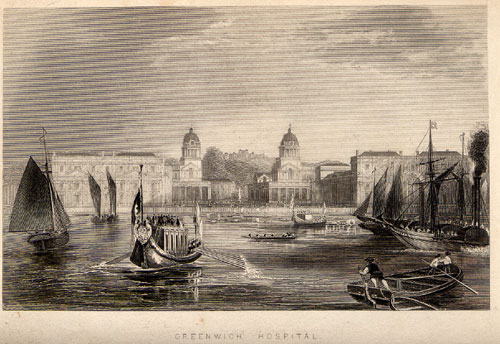|

NOTES ON THE NOVEL: ISSUE 15
Printable View
A Note on the Illustrations
The engraved illustrations of London reproduced
in this issue were prepared as a result of the Great Exhibition
of 1851. Tallis's Illustrated London (published in 1851-2,
in two volumes) was created specifically to commemorate the Exhibition,
and furnishes, not only a great many engravings of London scenes,
but also a long history of, and commentary on, the sights of London
and its environs. Since Tallis's Illustrated London was published
almost 25 years after the events related in this issue (Chapters
47-50 take place in 1829 [Meckier 160]), some of the views commemorated
in Tallis's would not have been available to Pip. Only those
illustrations that show cityscapes and landmarks as they would have
appeared to Pip in the 1820s have been included here.
A tour of chapters 47-50
In this issue, Pip continues his habit of rowing
up and down the river between his home at the Temple and Greenwich.
Tallis's Illustrated London offers views of several of the
landmarks he mentions or would have seen.
The engraving below shows the Customs House,
located just east of London Bridge, with part of the river in the
foreground. It thus duplicates, to some extent, Pip's perspective.
Because part of the Customs House, which had been laid on a faulty
foundation, had fallen in in 1825 (about four years before Pip's
rowing) and had to be re-erected (Tallis's Illustrated London,
vol. 2, 143-4), the building -- depending upon the extent of
its renovation -- may or may not have been in as perfect a condition
as shown in this image.

Pip rows down "as far as Greenwich with the ebb
tide" (Ch. 47), where the riverside is distinguished by Greenwich
Hospital.

Originally built as a new palace for the monarch
in the 17th century, the royal family spent little time there, and
the palace buildings became the center of a hospital for retired
and invalid seamen, opened at the beginning of the 18th century
(Tallis's, vol. 2, 91). The engraving above, like that of
the Customs House, shows the Hospital from the river, and thus duplicates
Pip's perspective.
The map below shows the chief landmarks along
the Thames that are mentioned in Chapters 47-50. Pip rows regularly
between the Temple and Greenwich. Hounslow Heath -- where the woman
Molly was accused of killing was strangled -- is located to the
west of London, at Hounslow.
The blue box in the center marks the area covered
by the Key Map of Collins' Illustrated Atlas of London.
The red box to the right of center marks the area -- "down the
Pool there between Limehouse and Greenwich" (Ch. 45) -- where Magwitch
is hidden.

Bed-furniture: When Wopsle marries, in
the play, a "young person in bed-furniture," the bed-furniture refers
to her clothing. Bed-furniture was not the bed itself, but rather
the furnishings of the bed -- linens, etc. (OED, "bed-furniture").
Over the broomstick, married: A "broomstick"
marriage was an illegal marriage, solemnized, according to the Oxford
English Dictionary, by having each party jump over a broomstick.
The term, common in the 19th century, has been in use since the
17th (OED, "broomstick").
Pudding in the cloth: The pudding to which
Dickens compares Wopsle's bag of money is probably a firmer sort
of pudding than the kind we are accustomed to today. In Dickens'
David Copperfield (1850), young David is able to buy "a slice
of pudding" (Ch. 11), which suggests that that pudding was
closer to our firmer puddings (such as bread-pudding) than to the
current conventional sort.
Bibliographical
information
|

